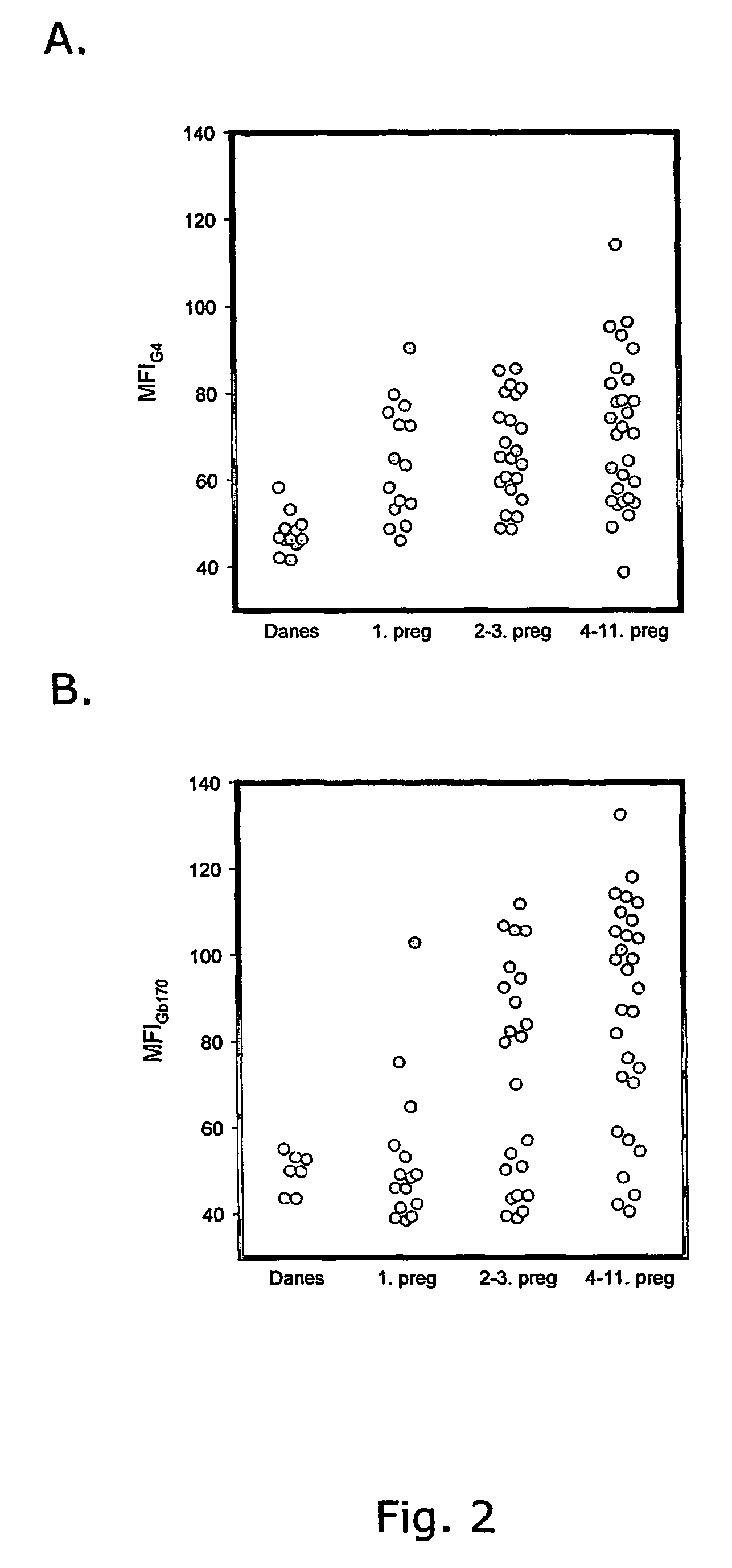Compounds useful in the diagnosis and treatment of pregnancy-associated malaria
a malaria and pregnancy-associated technology, applied in the direction of protozoa antigen ingredients, peptide sources, botany apparatus and processes, etc., can solve the problems of permanent catastrophe, parasite presence in pregnant women can have very serious consequences for both mother and child, affect millions of pregnant women and their offspring,
- Summary
- Abstract
- Description
- Claims
- Application Information
AI Technical Summary
Benefits of technology
Problems solved by technology
Method used
Image
Examples
example 1
Erythrocytes Infected by Placental P. falciparum Parasites Causing PAM are Serologically Distinct from Erythrocytes Infected by Other P. falciparum Parasites
[0447]Pregnancy-associated malaria (PAM) appears to arise as a result of the capacity of Plasmodium falciparum to express parasite-encoded variant surface antigens (VSA) on the surface of infected erythrocytes (IE). These VSA can mediate IE adhesion to glycosaminoglycans in the placental intervillous space. The higher susceptibility to PAM in primigravidae compared to multigravidae in areas of intense P. falciparum transmission implies that protective immunity specific for PAM-associated antigens can be acquired. The only prominent functional difference between erythrocytes infected by placental parasites derived from women with PAM and erythrocytes infected by parasites from non-pregnant malaria patients is a marked difference in the adhesive properties of the VSA expressed. It is therefore likely that acquired, PAM-specific pr...
example 2
IgG Specific for Parasite-encoded Variant Antigens on the Surface of Erythrocytes Infected by Placental and CSA-adhering P. falciparum Parasites Mediates Protection Against the Maternal Anaemia and Low Birth Weight Caused by Placental Malaria Infection
[0461]The major clinical consequences of PAM are severe maternal anaemia predisposing to perinatal maternal death and low birth weight (LBW) due to intrauterine growth retardation and premature birth.
[0462]To further substantiate the hypothesis that immunological protection against PAM is mediated by antibodies recognising a distinct type of VSA (VSAPAM) selectively expressed by placental parasites, the levels of IgG specific for VSA expressed in one placental parasite isolate (EJ24, Table 1) and one isolate from a male patient (Busua, Table 1) were measured in plasma samples from Kenyan women well-characterised with regard to PAM. The plasma samples were drawn from a larger previously described study cohort (Shulman et al., 2001). All...
example 3
Erythrocytes Infected by P. falciparum Parasites Selected for Adhesion to Chondroitin Sulphate A (CSA) in Vitro are Serologically Distinct from Erythrocytes Infected by Isogenic P. falciparum Parasites not Adhering to CSA
[0466]As described in Example 1 and Example 2, placental parasites express a unique type of VSA (VSAPAM). Thus, only P. falciparum-exposed women (who either are, or recently have been, pregnant) possess VSAPAM-specific plasma IgG, while such antibodies are uniformly absent from sympatric males. Pregnant women with PAM in the absence of VSAPAM-specific IgG are more likely to be anaemic and to deliver LBW babies than uninfected pregnant women or pregnant women with significant plasma levels of VSAPAM-specific IgG. For these reasons, VSA expressed by placental parasites (VSAPAM) is an attractive candidate for the development of a vaccine protecting against the clinical consequences of PAM, and molecular identification of such VSA thus becomes a priority.
[0467]Plasmodiu...
PUM
| Property | Measurement | Unit |
|---|---|---|
| temperature | aaaaa | aaaaa |
| pH | aaaaa | aaaaa |
| ionic strength | aaaaa | aaaaa |
Abstract
Description
Claims
Application Information
 Login to View More
Login to View More - R&D
- Intellectual Property
- Life Sciences
- Materials
- Tech Scout
- Unparalleled Data Quality
- Higher Quality Content
- 60% Fewer Hallucinations
Browse by: Latest US Patents, China's latest patents, Technical Efficacy Thesaurus, Application Domain, Technology Topic, Popular Technical Reports.
© 2025 PatSnap. All rights reserved.Legal|Privacy policy|Modern Slavery Act Transparency Statement|Sitemap|About US| Contact US: help@patsnap.com



